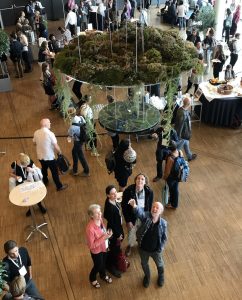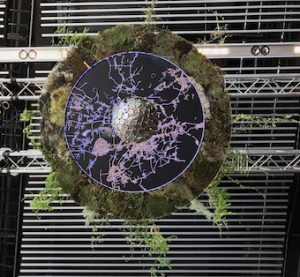Resilience Frontiers for Global Sustainability
Bridie McGreavy and Sam Roy represent the Mitchell Center at International Conference

At the end of August, Mitchell Center Postdoctoral Fellow Sam Roy and Assistant Professor of Communication and Journalism and Mitchell Center Faculty Fellow Bridie McGreavy journeyed to Stockholm, Sweden to take part in Resilience 2017: Resilience Frontiers for Global Sustainability—a three-day, multidisciplinary international conference.
Roy presented two posters on work he’s doing as part of the Future of Dams (FoD) team, and McGreavy gave a “flash” talk on her FoD work as well as a presentation on ongoing work she’s done as part of the Safe Beaches & Shellfish Beds (SB&S) project.
Following previous Resilience conferences, which have been held on triennial basis since 2008, the 2017 gathering discussed resilience as a key lens for biosphere-based sustainability science. It reflected back on the scientific progress made, and aimed to set out exciting future directions for research. A main focus was on global sustainability challenges and opportunities, which today are heavily influenced by the speed, scale and connectivity of the Anthropocene—the period of time during which human activities have had an environmental impact on the Earth regarded as constituting a distinct geological age.
“Bridie thought it would be good for us both to go to because we worked together fairly closely on the SB&S project and had a collaborative connection there,” says Roy. “And we’ve also been in discussion about FoD and were thinking about collaborations.”
McGreavy’s presentation focused on how the opioid crisis that is afflicting communities across Maine is also affecting Maine’s shellfishing industry—“How opiate addiction in a co-managed fishery threatens social-ecological resilience: An ethnographic study of shellfishing in Maine.” Her flash talk was on the process of Dynamic Design Planning, which she and colleagues have developed as a unique model for studying and shaping communication and collaboration practices within sustainability science—specifically in this case, decision-making around dams.
Roy’s first poster was about exploring different dam decision scenarios to see how the benefits received from river ecosystems, such as sea-run fisheries and hydropower, can be affected by dam removal or modification. His second poster detailed an innovative, multi-institution course that was created as part of the FoD project. The “Learning from Dams” course was designed, among other things, to introduce and build capacity for the growing field of sustainability science and provide an opportunity for students to learn more about each other’s research interests and disciplinary training.
Notes McGreavy, “One of the things that struck me immediately was that there was great representation from UMaine and the Mitchell Center at the conference.” In addition to Roy and herself, McGreavy says there were two former Ph.D. students, Eileen Johnson and Stacia Dreyer, who came through the Mitchell Center’s Sustainability Solutions Initiative. Also in attendance was Kara Pellowe, a Ph.D. student working in the UMaine Darling Marine Center with Heather Leslie.
“There was a good contingent from Maine, which said something to me about how we’re building capacity, participating in international forums on sustainability, and how our work is being recognized at that level,” McGreavy adds.
Roy says he was pleased at the level of communication between those in different disciplines. “I’ve been to a lot conferences where conversations are very narrow and high-level and focused within a certain discipline. At Resilience 2017, I was immediately struck by the ability to engage with people you’ve never met before and don’t know their backgrounds, but they were all very good at telling their stories and answering questions.”

He also notes that an important thread woven through the conference was the role of artwork in science and, specifically, sustainability science. “A couple of different components of that thread were ways researchers can communicate with artists to build collaborations to create art that’s meaningful emotionally but also scientifically.”
A prominent piece of art was a sculpture/installation that hung from the convention space ceiling titled “Nature/Society/Economy” by Norwegian artist Tone Bjordam.
“It was a sculpture that was meant to represent the connectivity between the biosphere and human culture and economics. It was a very artistic way of showing the dependences between these different components that are always coming up in sustainability science,” Roy says.
—David Sims
